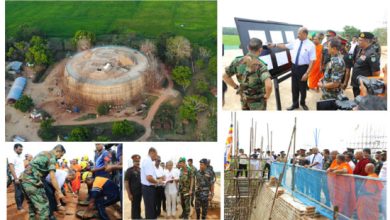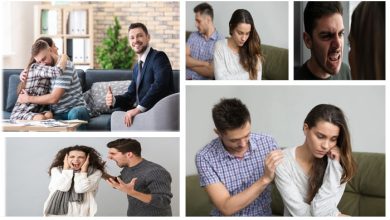The Portuguese Burghers of Sri Lanka
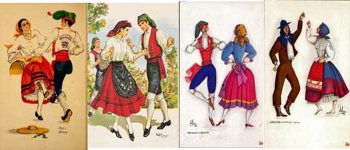
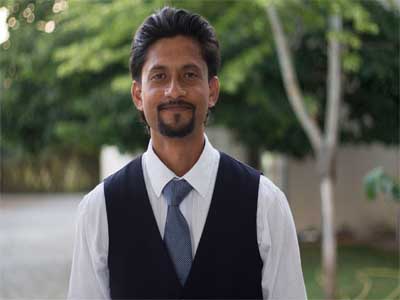
Sri Lanka is well known for its diversity with over 22 numerically small communities and majority communities such as Sinhalese, Tamils and Muslims. Burgher community is one of the numerically small communities. Large proportions of the Burghers do live in the Batticaloa District and a small proportion live both in Trincomalee and Ampara District. At the same time there are Portuguese Burghers living in all parts of the country in small numbers.
The Portuguese era marked the end of medieval Sri Lanka and the beginning of modern Sri Lanka. It changed the island’s orientation away from India and gave it a unique identity moulded by almost 500 years of Western influence due to the presence of three successive European powers : the Portuguese (1505-1658), the Dutch (1658-1796) and the British (1796-1948). The Portuguese cultural imprint can be analysed by examining: (a) those who claim Portuguese descent (the Portuguese Burghers), (b) those who do not claim Portuguese descent but who follow the Roman Catholic faith, (c) those who are neither of Portuguese descent nor follow the Catholic faith but nevertheless underwent a sociocultural transformation. Language is a necessary element in the set of culture. The other elements are subjective and could include religion, food, dress, music and dance.
The interaction of the Portuguese and the Sri Lankans led to the evolution of a new language, “Sri Lanka Portuguese Creole”, which flourished as a lingua franca in the island for over three and a half centuries (16th to mid-19th). Ceylon Portuguese was a prominent language and the mother tongue of the Portuguese Burgher communities and the first administrative language of Ceylon. Pidgins and Creoles are contact languages; they evolve when people who do not speak each other’s mother-tongue come into contact. Pidgins only survive as long as the interlingual contact lasts and are generally short-lived. The etymon of Pidgin is business. A Creole is a Pidgin which has become the mother-tongue of a speech community. Sri Lanka Portuguese Creole, a subset of Indo-Portuguese (the Portuguese Creole that flourished in coastal India), has been the solution to the inter-communication problems that arose when the Portuguese and Sri Lankans came into contact. In Sri Lanka, miscegenation reinforced the Creole as the mestiços (offspring of a Portuguese father and a Sri Lankan mother) were bilingual – they were proficient in the Creole and Sinhala or Tamil. Boxer (1961: 61) comments that the Eurasians (mestiços), or even slave women, kept alive the use of the Portuguese language in places like Batavia, Malacca and Ceylon (Sri Lanka), during the time of Dutch control following the Portuguese. Not to forget the separate court system that was followed for the Portuguese Burghers in the East during this time.
Portuguese forts
There are several Portuguese built forts all around the island. They are:
Kalutara fort
The Portuguese first built a fort in Kalutara and was surrendered to the Dutch in 1655 without a shot being fired; it was later enlarged by the conquering Dutch with the addition two bastions. Very little of it remains today.
Kayts Island fort and Delft Island fort
Kayts Island Fort, also known as Urundai Fort, was built by the Portuguese in 1629 and was abandoned in 1651. In the late 1600s, the Dutch took control of the fort however they did not undertake any renovations, unlike many of the other former Portuguese forts. The fort is horseshoe shaped with four circular bastions, built to protect the Jaffna Peninsula.
Mannar fort
Built on the island of Mannar by the Portuguese in 1560, it surrendered to the Dutch on 22 February 1658 and was rebuilt by the Dutch in 1696. On 5 October 1795 the Dutch surrendered to the British. The fort has four bastions and it’s still in good condition.
Matara fort
The fort was built by the Portuguese about 1550 but the actual fort was built by the Dutch when they took Matara, after the capture of Galle. The remains of the fort are in good preservation.
Menikkadawara fort
Menikkadawara fort was built by Portuguese in 1599 with the intention of operations against Kandyan forces. It was not major fort, but it had strategical important. Dutch map indicates it as “Tontotte fort”.
Negombo fort
A small but important fort in the town of Negombo, north of Colombo was built by the Portuguese to defend Colombo. In 1640 the Dutch destroyed it and rebuilt it not on the usual square pattern, but on a pentagonal one, though it had only four bulwarks. The fort was located on a narrow strip of land between a lagoon and an inlet of the sea. It was surrounded by moats, and the gate was accessed via a drawbridge. The English occupied it in 1796. Today only part of the walls and an arched gateway remains of the fort. It is used as a prison by the Department of Prisons.
Pooneryn fort
Built in the Pooneryn area of north portion of the island first by the Portuguese to protect its possessions in Jaffna, it was expanded by the Dutch till in 1770 it was recorded that it was square shaped with two bastions at opposite corners; the rampart on each of the sides was about 30 metres and was garrisoned till the late 18th century. The British built a rest house in 1805. Since 1983 due to the civil war it was garrisoned by the Sri Lankan Army till it withdrew from the Pooneryn area in 1991; and recaptured in 2009. Ruins of the fort remains, however in bad condition.[3]
Ratnapura fort
The fort was built by the Portuguese, between 1618 and 1620, in Ratnapura. It was later captured and destroyed by the Kandyan king Kirti Sri Rajasinha.
Ruwanwella fort
It was originally built as stockade in the 1590s by the Portuguese; however, the Dutch, in 1665, built a wooden fort. The British, in 1817, built a new fort with two bastions and used as an outpost. Today it remains in good condition and houses a police station.
Hanwella fort
The original fort was built by the Portuguese in 1957, at Hanwella. The fort was subsequently captured by the Dutch, who constructed a larger fort. In 1786 it fell under the British rule and fell into disrepair. The site is currently occupied by the Hanwella Rest House and the ruins of the fort can still be identified.
Batticaloa Fort – 1628
Jaffna fort – 1618
The Portuguese forts which were captured by the Dutch were named as Dutch Forts and now they are called the Dutch Forts.
Historical background
The Portuguese who landed in this island at the beginning of the sixteenth century held way over its maritime provinces for well over a century.
History reveals that Batticaloa was taken by the Portuguese and retained as part of their occupied territory until 1639 when the Dutch made themselves of this District.
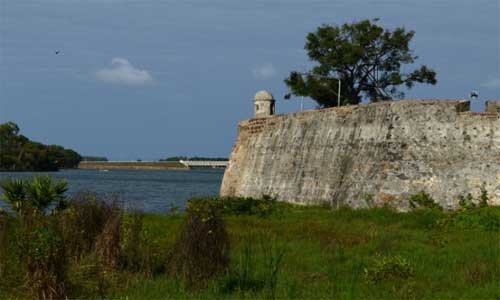
About the 15th century, Batticaloa District formed part of the Kandyan Kingdon, when the Sinhala Kings held away, and Batticaloa was known as ‘Puliyanduwa’. Though known as Puliyanduwa in the days of old, Batticaloa did have another name of ‘Mada Kalapuwa’. The Portuguese who came in gave this town a new name ‘Batecalou’ and this name was changed to ‘Batticalou’ by the Dutch and to ‘ Batticaloa’ by the British who followed the Dutch. Joa and de Cute states that the District had much rice which they called Bate, hence the Portuguese called the Batticaloa District ‘the Kingdom of Rice’. The British anglicised Batecalou to Batticaloa and called it the ‘Greenery of the East’.
During this period, the Portuguese did build a Fort in Batticaloa on a site least vulnerable from sudden attack and inaccessible to big vessels from the sea. The fort was erected in a corner of Puliyantivu which was surrounded by the Batticaloa lagoon. This lagoon formed a natural barrier against attack on two flanks of the fort. The moat served as an adequate line of defence on the land side.
The Portuguese though overpowered in Batticaloa by the combined army of the Dutch and the Sinhalese were nevertheless fearless, brave and untiring warriors. During the Dutch and the British period, these Portuguese Burghers are said to have suffered much, and when the subsequent conquerors expelled these Portuguese descendant from their kingdom, they are believed to have been settled in certain parts of the Kandyan Kingdom.
The Sinhala Only Act, formally the Official Language Act No. 33 of 1956, was an act passed in the Parliament of Ceylon in 1956. The act replaced Sinhalese as the official language of Ceylon. The act was controversial as supporters of the act saw it as an attempt by a community that had just gained independence to distance themselves from their colonial masters, while its opponents viewed it as an attempt by the linguistic majority to oppress and assert dominance on minorities. During this period most of the well-educated Burghers left the Island and migrated to other countries.
Then followed the prolonged war and tsunami which paved the way for the Burghers to internally displace and also migrate to other countries too. We would like to create links and establish connection with the Burghers who are displaced and migrated.
What are the different names they are called?
It has been common practice in discussing the Burghers of Sri Lanka to distinguish between those of Dutch descent, the “Dutch Burghers”, and those of Portuguese descent, the “Portuguese Burghers”, or more derogatorily, the “Portuguese Mechanics” or “Dhurai”. In Tamil the term “Parangi” and Sinhala “Lanci” is used to address the Portuguese Burghers. Some of the locals address the Burghers as “Dhurai” When Portuguese arrived in Sri Lanka the Arabs were trading from Sri Lanka and the Portuguese were named as “Firanji” both in India and in Sri Lanka. With time the term “Firanji” has become “Parangi” and the Portuguese Burghers in the East are addressed as by the Tamils with this particular name and is documented in the stat istics at the Divisional Secretariats.
With the initiation of Mr. Earl Barthelot, (2010-2014) area committees were re-formed in areas where Burghers are living in villages in the Eastern Province which now counts to 15 including of those from Trincomalee and Akkaraipattu. Our aim is to extend our Burgher membership to those living in what is known as ‘outstation’ areas of Sri Lanka. We would especially like to welcome those living in Jaffna, Mannar, Matara, Kandy, Hambantota etc.
We extend a warm welcome to join us in preserving and nurturing the Burgher community, to proffer the goodwill of our community across other communities and join hands with others to help those in need, especially those with ailing health, and the young, with education and employment opportunities.
- Inter relationships
Some commentators believe that the Burghers’ own mixed backgrounds have made their culture more tolerant and open. While inter-communal strife has been a feature of modern Sri Lankan life, some Burghers have worked to maintain good relations with other ethnic groups. However, prejudices within the community as a result of a condescending attitude outside of it, have caused some migrant Burghers to take on the traditions of the country in which they reside and disconnect from the ties to their country afterwards.
Many Sinhalese adopted Portuguese surnames-although most were modified to a degree-but this practice did not necessarily denote conversion to Roman Catholicism. Such names (and their Portuguese form) include Corea (Correia), Croos (Cruz), De Abrew (Abreu), De Alwis (Alves), De Mel (Melo), De Saram (Serra), De Silva (Da Silva), De Soysa or De Zoysa, Dias, De Fonseka or Fonseka (Fonseca), Fernando (Fernandes), Gomes or Gomis, Mendis (Mendes), Perera (Pereira), Peiris or Pieris (Peres), Rodrigo (Rodrigues), Salgado, and Vaas (Vaz). These two last examples are well-known both in in Sri Lanka and in the international arena. Chaminda Vaas, Cricketer, formerly Sri Lanka’s most successful new-ball bowler and Field Marshal Honourable Sarath Fonseka, He was the eighteenth Commander of Sri Lankan Army, and under his command the Sri Lankan Army ended the 26-year Sri Lankan Civil War in 2009.
- Salient features
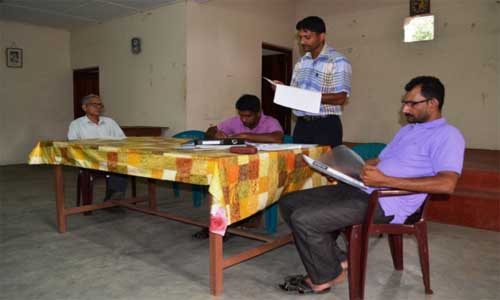
Burghers may vary from generation to generation in physical characteristics; some intermarried with the British and produced descendants with predominantly European phenotypes, including fair skin and a heavier physique, while others were almost indistinguishable from Sinhalese or Tamils.
Phenotypically Burghers can be either light skinned or dark skinned, depending on their ancestral history it is common to find Burghers with dark to light brown skin (usually Portuguese Burghers) and possess European facial features common to the Mediterranean basin. In some Portuguese Burgher families it is common to have both, very dark children and children with fair skin.
- Current status
The Burgher population in the District of Batticaloa only forms 5% of the population, while the Tamils are a majority community and the Muslims come a second. Hence very often the results of the election, quite naturally showed that the voters had always been community conscious. The first MP had always been a Tamil and very often the second MP was a Muslim. It is natural, probably, that after the elections, the 1st MP had to look after the interests of the Tamil population while the 2nd had to cater to the needs of the Muslims.
After the country gained independence, the Government decided that the children should be taught in the mother tongue. For the children who were neither Tamil nor Sinhala the option to have their education in their own mother tongue which are either Portuguese or English, was not provided by the Government of Sri Lanka. In Batticaloa, for the community that formed five percent of the population the choice to have the education in their mother tongue was not facilitated or provided by the then Government of Ceylon. The parents were not given a choice. Whether they liked it or not, they were forced to send their children either to the Sinhala medium or Tamil medium schools.
These children had to learn one of these languages and compete with those whose mother tongue had been the national languages. Universities thus became out of bounds for these children. Job opportunities were nil, for they had not only to compete with the Tamil and Sinhala children, but also have had the need to make the necessary entries in the ‘Race’ column.
Presidential commission on constitutional reform in Sri Lanka recently visited Batticaloa to record the grievances. I highlighted the following:
- Portuguese Burghers feel and realize that the Burghers are not recognized as a community in Sri Lanka for following reasons. a. In the census Portuguese Burghers are mentioned as others, even in the District Secretariat statistical book too. Therefore it must be mentioned as “Portuguese Burghers”. b. Burghers are not allowed to wear our cultural or traditional dress at work place, this should be included in the constitution and if it is mentioned already, it should be reinstated. c. We are not given equal ground or right to learn, teach and speak our mother tongue at school or any other places. Opportunities for Burghers should be created to study their mother tongue at schools. d. Our existence and history is not taught at school or media. Other communities too should learn the history of Burghers, existence, culture, tradition, cuisine, dress, sports etc at school and at the University which will bring knowledge, understanding, acceptance, co-existence and unity in the country. e. We are not given any opportunity or chances to practice, learn and to preserve our culture, heritage and tradition to our younger generation and to maintain the artefacts that remain the country. Opportunities should be given for these. f. Our heritage and our traditional game is football. Burghers are not given any facilities or motivation to play and practice the game of football. We the Eastern Portuguese Burghers need at least a playground to play. g. Burgher names are difficult to be written in the local languages. We prefer to write it in English. But our need is not recognized in this country at present. Birth certificate, Marriage certificate, National Identity card etc are the preferred documents. h. Job opportunities for the Burghers at government institutions are not given. The percentage systems of giving job opportunities affect the Burghers, as the Burghers are numerically small and not even 1% of the entire population in Sri Lanka. This situation should be changed. i. Election system in Sri Lanka does not give room for numerically small communities such as Portuguese Burghers to represent at the parliament, municipality, provincial council or Pradeshiya Sabha. Numerically small communities should be treated equally and impartially as other communities. j. We believe Sri Lankans have the right to practice any religion. The government does not recognize the religious rights of the numerically small communities. Therefore we do not enjoy the rights enjoyed by the majority communities. k. War and tsunami has made the Portuguese Burghers seek shelter in different parts of the country. No efforts taken towards gathering the Portuguese Burghers at one place at least once in a year. We need a place such as Nelum Pokana for the Eastern Burghers.
- Sri Lankan Government do not take any efforts to maintain ties with the Portuguese government to the extent it is done by the Indian government especially in Delhi and Goa. As the SL government is allowing the Indian government to help the Tamils in Sri Lanka, if the Portuguese government is allowed to help the Portuguese Burghers in the East, it will help the country at large.
- The National Flag should symbolize the diverse communities that live and the Unity and co-existence and peace in Sri Lanka.
- Local industries that belong to each community must be recognized and embraced.
- In the Independence Day celebrations and events Burghers also should be included.
The Burghers of Batticaloa are today a frustrated lot for these reasons.
We have problems unresolved. These problems are discussed quite regularly at our meetings of the Burgher Union. But, or what use of it? How far can our voices travel?
- Population and Geographical distribution
At the 1981 Census, the Burghers (Dutch and Portuguese) were almost 40,000 (0.3% of the population of Sri Lanka). Many Burghers immigrated to other countries. There are still 100 families in Batticaloa and Trincomalee and 80 Kaffir families in Puttalam that still speak the Portuguese Creole; they have been out of contact with Portugal since 1656. The Burgher population worldwide is approximated to be around 100,000, concentrated mostly in the United Kingdom, Canada, Australia and New Zealand.
Latest information on population distribution by the Batticaloa District Secretariat.
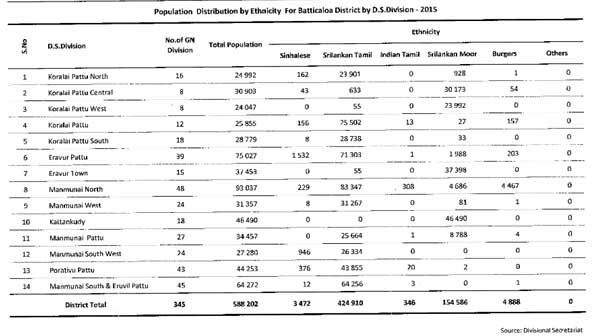
- Language
This community of people have still not forgotten their language Portuguese. The Portuguese spoken by them has been described as Creole Portuguese. Ian R. Smith in his books has stated that the Portuguese spoken today has incorporated some distinctive features of the local Batticaloa Tamil dialect. The long and tenacious history of the Creole Portuguese speech in the island, Batticaloa harbours the only significant concentration of creole speakers now in Sri Lanka and their fluency is being strongly threatened by the local emphasis on Tamil.”
The Portuguese descendants have not, to a great extent, followed the local Tamil/ Moor kinship structure. There is very little evidence of ‘close’ cross cousin marriage. Probably this may be due to the Catholic ban on marriage within the prohibited degrees of kinship.
Sinhala and Tamil words of Portuguese origin
This vocabulary influence was remarkable: there was a rapid absorption of
perhaps a thousand Portuguese words into Sinhala and Tamil. These “loan
words” as they termed by lexicographers rarely appear in the same form as
the original; the vast majority have undergone naturalisation.
Examples include: almariya (wardrobe), annasi (pineapple), baldiya (bucket),
bankuwa (bench), bonikka (doll), bottama (button), gova (cabbage), kabuk
(laterite, a building material), kalisama (trousers), kamisaya (shirt), kussiya
(kitchen), lensuwa (handkerchief), masaya (month), mesaya (table), narang
(orange), nona (lady), paan (bread), pinturaya (picture), rodaya (wheel), rosa
(pink), saban (soap), salada (salad), sapattuwa (shoe), simenti (cement),
sumanaya (week), toppiya (hat), tuwaya (towel), viduruwa (glass).
- Religion/s
The Portuguese Burghers are Catholic to a man and generally devoted Catholics too. The Catholic Church (Chapel) at the Sand Bar dedicated to the Our Lady of Voyage is believed to have been constructed by the Portuguese.
- Life style
The majority of the Portuguese descendants are craftsmen. Among these mechanically gifted people are found expert black smiths, key smiths, leather product makers, master carpenters, tailors, printers, painters and mechanics. Out of cast – off pieces of iron, these gifted Burgher mechanics forge many articles noted in the town for their cheapness and high quality. These range from parts of heavy machinery to kitchen knives. With a long tradition of mechanical aptitudes behind them, there is practically nothing that is beyond capabilities of these black- smiths.
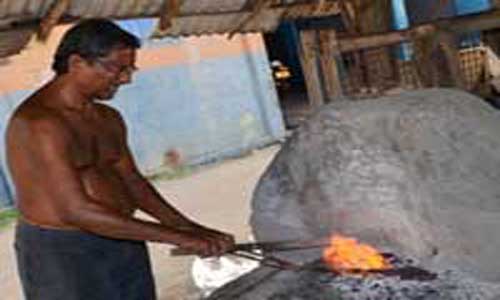
These Portuguese craftsmen are not only talented blacksmiths and gifted carpenters. Until recently when the Government decided to withdraw all firearms from the residents of Batticaloa for security reasons, Batticaloa’s only gunsmiths were Portuguese Burghers. With the withdrawal of guns, these men have been forced to put their shutters down or turn to other crafts like carpentry and cycle repairs.
Till recent times, the only owners of printing presses in Batticaloa have all been Burghers. Even in the Printing press managed by the Catholic clergy, the master printers and binders were all of Portuguese origin. It is an undeniable fact that Batticaloa’s best painter and block maker was the later Clarence Hendrick, also a delightful musician. He was a violinist without whom no Burgher function was complete.
At a time when English was the medium of instruction in schools, the children of these Portuguese Burghers were in a better position to seek white collar jobs. The community had given the town some of its finest public servant and teachers and many Catholic priests. In addition to these priests, there are quite a number of nuns in the various congregations working both in the diocese and outside it.
In addition, there are a few of the members of the community who have been able to secure positions in the administrative and banking service.
- Food and costume
Most Burgher people have preserved Western customs; especially among those of Portuguese ancestry their European religion, language, and surnames are retained with pride.
Burgher culture is a rich mixture of East and West, reflecting their ancestry. They are the most Westernised of the ethnic groups in Sri Lanka. Most of them wear Western clothing, it is not common for a man to be seen wearing a sarong, or for a woman to wear a sari.
A number of elements in Burgher culture have become part of the cultures of other ethnic groups in Sri Lanka. For example, baila music, which has its origin in the music of 16th-century Portugal, has found its way into mainstream popular Sinhalese music. Lacemaking, which began as a domestic pastime of Burgher women, is now a part of Sinhalese culture too. Even certain foods, such as love cake, bol fiado (layered cake), (savoury meatballs) and lamprais, Thrutha, Bafal, Oil cake, Bread, Pickle, Milk toffee, Pasan, Popochi, Pemprethu, cookies, empatha, Pork curry, muskat, varieties of soup have become an integral part of Sri
Lankan national cuisine.
Those who assume that Sri Lanka’s hot curries were the creation of the Islanders will be surprised to learn that the Portuguese introduced chillies to the local cuisine. Until then, pepper had been the means by which curries were given a ‘heaty’ (Sri Lankan English) taste. Not so surprising, considering the local lack of knowledge regarding bread revealed in the comment that the Portuguese ate “hunks of white stone”, is that they were responsible for the establishment of bread-making. They also introduced the tomato. The Islanders took to Portuguese cakes, such as the bolo fiado or bolo folhado, a layer cake filled with cadju (cashews), and sweets such as boruwa Oil cake, Bread, Pickle, Milk toffee and fuguete. And many of the Sri Lankan sweetmeats are of Portuguese origin
Illustrations in Portuguese and Dutch descriptions of the Island in the 16th and 17th centuries reveal that the Sinhalese soldier’s dress was of Portuguese influence. There is an engraving from Description of Malabar and Ceylon (1672) by the Dutchman Philip Baldaeus that depicts the reception of his fellow-countryman, explorer Joris van Spilbergen, by King Vimaladharmasuriya I. The king’s guards are shown wearing a Portuguese-type helmet, white jacket and kilt.
Moreover, the kings of the Portuguese, Dutch and British era invariably wore Portuguese costume, complete with hat and shoes. This is demonstrated in Robert Knox’s “An Historical Relation of Ceylon” (1681), in which there is an illustration of King Rajasingha II (1635-1687). “His apparel is very strange,” Knox remarks, “not after his own country. He has a long band hanging down his back of Portuguese fashion.”

- Important events (Social, Cultural practices etc)
Although the Portuguese have carefully maintained the traditions and customs of their ancestors, it must be admitted that today their customs are a quaint and mixture of both East and West.
In time, the Dutch and Portuguese descendants intermarried. Under Dutch rule Portuguese was banned, but the Portuguese speaking community was so widespread that even the Dutch started to speak Portuguese.
In the 18th century, the Eurasian community (a mixture of Portuguese, Dutch, and Sinhalese as well as Tamil, known as the Burgher) grew, speaking Portuguese or Dutch.
Sketch of baila dancers from frescoes at the Purvarama Vihara, Kataluwa (1886)
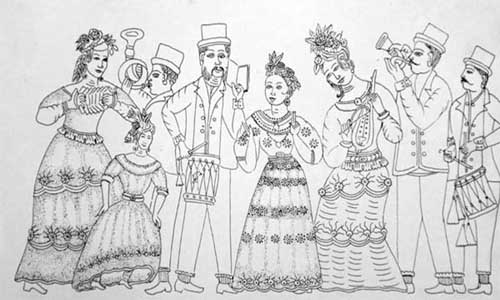
The Portuguese Burghers were more mixed, following Catholicism and speaking a Portuguese creole language. Despite the socio-economic disadvantage, the Burghers maintained their Portuguese cultural identity. In Batticaloa, the Catholic Burgher Union reinforced this. The Portuguese Creole continued to be used amongst the Dutch Burghers families as the informal language until the end of the 19th century.
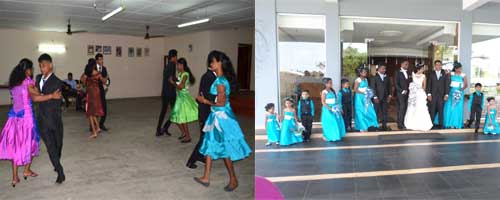
In today’s Sri Lanka, the Creole is limited to the spoken form. Most of the speakers are the Burghers in the Eastern province (Batticaloa and Trincomalee). But there are also the Kaffirs (people of African origin) in the Northwestern province (Puttalam). The Portuguese, Dutch and British brought the Kaffirs to Sri Lanka, for labour purposes. They have assumed Portuguese culture and religion.
The Portuguese Burghers have very carefully maintained their traditional Portuguese Drill (Kaffringha), and and Lancers dance. No wedding or even a smaller social function like a birthday party or coming of age function is complete without a dance and a meal together. The traditional custom of celebrating a wedding for four days is generally maintained.
- Importance of respective communities towards national integration
The Burgher community had contributed largely to the survival of this country as a sovereign, independent, nonaligned country. As mentioned earlier, the Burgher community had always supported a political party which apparently stood for equal opportunities to all. We had, at every turn, opposed any division of the country. Though we, as a community, liked to maintain our identity, we lived very peacefully and advocated co –existence. Our children today can speak both the national languages quite fluently. We have made our own contribution, a rather substantial one, in the development of the district.
A great majority of the residents in Batticaloa Town are Catholics. It was the Portuguese who brought this faith in the shores of this island. St. Michael’s College which is a leading school in the island and which has put Batticaloa on the map by successfully winning basketball tournaments have all had the support and assistance of the Burgher population.
The Burgher population of Batticaloa freely mixes with other communities. The Special Problems of the Community are varied. Although there is a Burgher Union to cater to the social and intellectual needs of the population, yet there are other urgent needs of the group.
For centuries, the Burgher population of Batticaloa have lived and died amidst the Batticaloa Tamil and Muslim population. But they still remain a distinct group, small but stubbornly separate. They love and respect the indigenous population, but they very seldom merge. Of course, there are rare instances of inter marriage. Some boys and girls have married from the Tamil and Sinhala population and sometimes even Muslim and Malay families.
There may be more than one reason why they do not wish to lose their identity as Burghers. Quite a number of them are on preserving their language and culture. No wedding or funeral is complete without the traditional customs being followed. Probably, the Portuguese descendants feel that they are a small minority and cannot afford to mix, lose their identity and pave the way for the eventual extinction of the community that had preserved itself for such a long time.
It may be that eventually the race may face extinction, for besides being continually forced to grapple with economic problems, a form of inbreeding is slowly setting in, sapping the strength of this five-century old community in this country. Perhaps, there will be no help or assistance forthcoming from their country of origin, for the Embassy of Portugal was closed down in Colombo years back and New Delhi overlooks this island too.
The Portuguese descendants of Batticaloa have never played an active role in the Parliamentary politics of the island. They have had neither opportunity nor chance to put forward a candidate of their own for a seat in Parliament nor had an idea of forming a party of their own. This community has always stood for a United Sri Lanka and hence never had the intention of supporting any party opposed to this idea.
Even during the Referendum and the election of the First ever elected President of Sri Lanka, the Burghers supported the UNP. But what they got in return was only the satisfaction that the party they always supported won by an overwhelming majority
- Other
- Cultural diversity
Batticaloa Burghers are a significant socio –cultural phenomenon of the Eastern part of Sri Lanka which is also enriching component of the socio –cultural aspect of Sri Lanka. The unique practices of the Burgher community contribute to the multicultural nature of both Batticaloa and Sri Lanka as a whole.
Engaging and involving Burgher community in Batticaloa and Sri Lanka is an act of establishing and celebrating differences in cultures and enriches the practices of equality and equity in every aspect of the social strata. Engaging the Burghers not only in Batticaloa but also Island wide would create more opportunities for the Burghers and other communities in Sri Lanka to know, understand and accept the multicultural aspect of Sri Lanka as well as for the unity, co-existence and peace in Sri Lanka. Not only the Burghers but also other numerically small communities should be given opportunities in the same way.
- Information about their organization, different associations, sport association etc.
Traditional Game:
Foot Ball is the Traditional game of the Portuguese Burghers. In Sri Lanka, it is the Portuguese Burghers who introduced the game of football and at the District level football is very common and the Eastern Province is well known for the game of football too.
Burghers’ Recreational Club represents the Burghers of the Eastern Province in Batticaloa. With the ethnic conflict and 3 decades of war, it faced with many challenges and after the tsunami in 2004 the club lost its resources and in the brink of extinct.
- List of key references
Mr. Stanislous Ockersz, Mrs. Rachel Outschoorn, Antony Ragel
(https://en.wikipedia.org/wiki/Burgher_people)( McGilvray 2007 Portuguese Burghers & Tsunami (1)( Smith, IR. Sri Lanka Portuguese Creole Phonology. 1978. Dravidian Linguistics Association.)( https://en.wikipedia.org/wiki/Portuguese_Burghers))
(Photos – Men, Women, Children (with different age categories) different stages of their life, important events etc)


